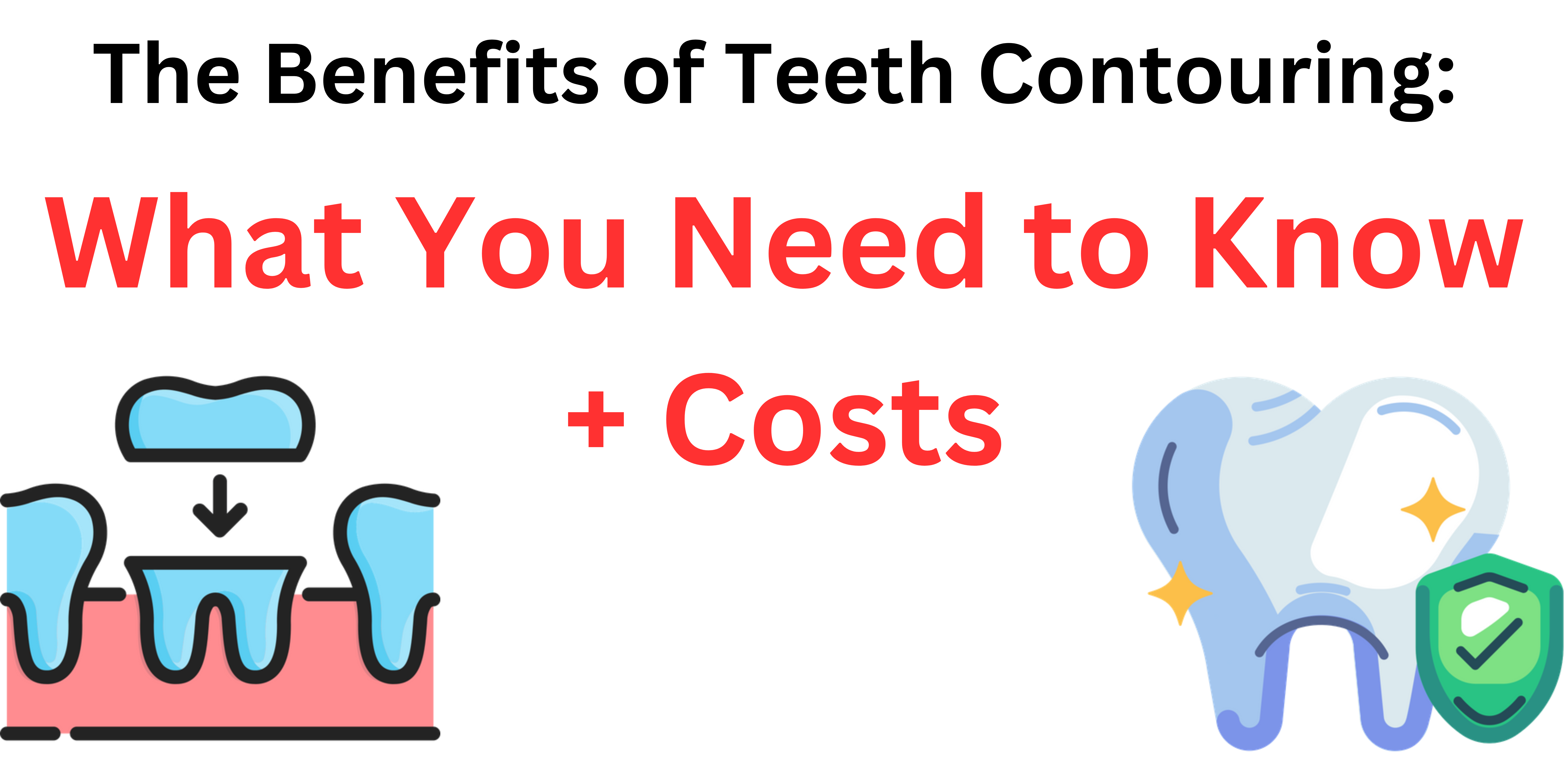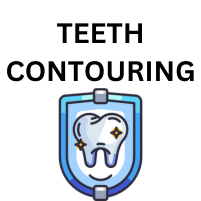Teeth contouring can transform your smile, but is it worth the price? Discover the cost and benefits of this popular cosmetic dental treatment.

Dental contouring is one of the fastest, least expensive, and least invasive dentistry procedures. The procedure involves shaving the enamel to enhance the teeth’ shape.
Suppose you have cosmetic dental problems like chips, cracks, stains, and slight unevenness. In that case, Cosmetic contouring is an option that you can consider.
Enameloplasty, or reshaping or enameloplasty, must have sufficient enamel before proceeding. But it’s best to talk to your dentist first to find out if you’re a good candidate and get a look at your teeth.
The Procedure For Dental Contouring: Before And After
Dental molding or tooth reshaping, or in dentistry terms, enameloplasty, is a strategy to change the state of your teeth for an even and appealing grin. Enameloplasty involves removing enamel from the teeth, particularly the front incisors, to alter their shape.
People with minor flaws like cracks, overlaps, stains, and marks benefit most from contouring. That does not necessitate invasive treatments.
Dental Contouring Procedure: How Do Teeth Contouring Work?
You must consult a licensed dentist before we get into the specifics of the procedure.
Now we get into the specifics of the cosmetic procedure and some things to know to understand it better: 
- Dental Evaluation
- Teeth Marking
- Contouring/Shaping
- Dental Bonding
 Dental Evaluation
Dental Evaluation
Contacting a licensed dentist before we enter the procedure’s specifics is essential. The dentist will typically examine the teeth’ condition before beginning dental contouring.
To ensure the teeth’ health, dentists take several X-rays and conduct a thorough examination. They determine whether the teeth can be reshaped and how much enamel is present.
Veneers are what your dentist will recommend if there isn’t enough enamel. Because of this, having sufficient enamel is one of the most crucial requirements for contouring.
 Teeth Marking
Teeth Marking
Your teeth are also known for being precisely shaped by dentists, who mark and label them following the examination. They digitally scan the teeth and modify the digital impression.
Additionally, many dentists perform this step manually before beginning the contouring process. For the patient to express what they want, the patient’s discretion is also an essential step at this point.
According to research, this procedure can occasionally be beneficial for adjusting the bite and aligning the teeth. Dentists focus on problematic areas with cosmetic issues like cracks, stains, or marks during the marking procedure. They label the teeth with tools like orthodontic pens to make precise changes.
 Contouring/Shaping
Contouring/Shaping
Dentists begin the shaping process after marking the problem areas on the teeth. During the teeth contouring, the dentist shaves a thin layer of enamel using sanding instruments or a drill to avoid placing excessive pressure on the tooth.
For instance, dentists gently buff away the surface with a sanding disk to remove a stain from one of the incisors. Dentists frequently prescribe the procedure before orthodontic treatments like braces or aligners. Preparation is required before these treatments to achieve your desired results before the teeth contouring process.
However, you can choose this procedure without the need for orthodontic treatment. If a few minor flaws prevent you from smiling confidently, contouring may be an option.
Suppose your teeth don’t coordinate with the other teeth and have spiked edges. In that case, this technique works perfectly to accomplish uniform teeth. Contoured teeth are an excellent, non-invasive way to achieve smaller teeth when desired.
 Dental composite or bonding
Dental composite or bonding
Restoring portions of the tooth where the enamel has been removed is the final and most crucial step in this procedure.
For instance, a patient with prominent dark stains on the incisors requires bonding to restore a tooth to appear natural. Dental bonding is crucial in contouring because the tooth becomes more vulnerable once they remove the enamel.
The tooth’s restoration is also essential for the tooth’s health and for preventing future dental issues. The bonding is ensured to be the same shade as the tooth for a more natural appearance.
Teeth Contouring: How much time does the process take?
Dental contouring is a straightforward and quick procedure. It usually takes no more than 30 minutes, but the amount of teeth that need to be contoured also plays a role. Because it is a non-invasive procedure, there is no need for any preparation or anesthesia.
As a result, there are no complicated procedures, and the process is relatively short and painless.
Pros and Cons Of Teeth Contouring
If your teeth are crooked or uneven, consider tooth contouring. However, there are still some benefits and cons to this method:
Pros
![]() Simple and quick procedure: The fact that contouring is a simple and fast procedure that takes no more than 30 minutes is one of the enormous benefits.
Simple and quick procedure: The fact that contouring is a simple and fast procedure that takes no more than 30 minutes is one of the enormous benefits.
![]() Cost-Effective: One of the quickest ways to get well-aligned teeth without spending much money is through contouring.
Cost-Effective: One of the quickest ways to get well-aligned teeth without spending much money is through contouring.
![]() Non-invasive: The fact that contouring is completely non-invasive is another significant advantage. Sanding disks or lasers are used by dentists to alter the shape and length of teeth.
Non-invasive: The fact that contouring is completely non-invasive is another significant advantage. Sanding disks or lasers are used by dentists to alter the shape and length of teeth.
![]() An Improvement in Oral Hygiene: Because it is challenging to clean overlapping teeth properly, there is a greater risk of decay accumulation.
An Improvement in Oral Hygiene: Because it is challenging to clean overlapping teeth properly, there is a greater risk of decay accumulation.
It is possible to remove the enamel that causes the teeth to overlap by contouring. It not only improves the alignment of the teeth but also enhances overall oral hygiene and makes it simpler to clean them.
![]() The grin that looks better: Your smile looks better due to the procedure, which aims to change the shape of your teeth. It enhances your teeth’s contours, making them appear more aligned and straight.
The grin that looks better: Your smile looks better due to the procedure, which aims to change the shape of your teeth. It enhances your teeth’s contours, making them appear more aligned and straight.
It is a straightforward method for treating minor dental flaws like stains and cracks.
Cons
![]() Risk of sensitivity: There is always a risk of oral sensitivity because contouring involves removing a significant amount of the tooth’s enamel.
Risk of sensitivity: There is always a risk of oral sensitivity because contouring involves removing a significant amount of the tooth’s enamel.
Veneer shields our teeth from harm and diseases. As a result, it’s critical to pick a dentist specializing in orthodontic care. Additionally, sensitivity raises the likelihood of gum disease and tooth decay.
![]() Great for minor changes: Only individuals with minor dental flaws, such as minor cracks, stains, and overlapping teeth, are candidates for contouring. Contouring cannot address more complicated issues like overbite and underbite or overcrowding.
Great for minor changes: Only individuals with minor dental flaws, such as minor cracks, stains, and overlapping teeth, are candidates for contouring. Contouring cannot address more complicated issues like overbite and underbite or overcrowding.
![]() Not sustainable: Even though forming is painless and savvy, assuming one disregards their oral well-being, it will only endure a little.
Not sustainable: Even though forming is painless and savvy, assuming one disregards their oral well-being, it will only endure a little.
Who is Suitable for Teeth Contouring?
Even though contouring is quick and non-invasive, only some are good candidates. Understanding a patient’s situation necessitates a dental examination or checkup. Light stains, minimal overlap, cracks, and teeth that are slightly uneven are all good candidates for contouring.
For complicated problems like excessive crowding, receding gums, receding bone, and loose teeth, teeth contouring is not a method that works well. The ability of an aesthetic dentist to determine who is a good candidate for tooth reshaping is essential.
Teeth Contouring Cost: How much is Dental Contouring?
Although teeth contouring requires little expertise, it must remove the enamel. You must choose an experienced cosmetic or orthodontic dentist if you want teeth contouring.
According to American Cosmetic Dentistry, teeth contouring costs range from $50 to $500 per tooth. However, this price varies depending on the condition of the patient.
The teeth contouring cost is significantly lower than other dental procedures, making it one of the least expensive options.
Possible side effects of Dental Contouring:
Although teeth contouring is painless and non-invasive, some possible side effects exist. As you know, teeth contouring involves removing enamel to correct cosmetic flaws, which may irritate.
Oral sensitivity is risky if the dentist removes too much enamel. In the long run, excessive enamel removal also has adverse effects, such as making teeth more susceptible to decay and tartar buildup.
In addition, excessive enamel removal causes gum irritation. Due to teeth contouring, there is a possibility of weak and loose teeth in extreme cases.
These are some of our research inquiries regarding teeth contouring. If you’re thinking about changing the shape of your teeth, you should learn as much as you can.
Is Dental Contouring Bad?
Teeth contouring is a quick way to get teeth that are even and aligned. Still, there are different opinions on it simultaneously.
Although the procedure is not particularly strenuous, it involves filing the teeth into the desired shape by removing a thin enamel layer.
Because enamel is a layer that keeps your teeth safe from harm, they tend to become more vulnerable when filed. The tooth becomes sensitive if the enamel becomes too thin during the procedure.
Additionally, the tooth becomes weaker if insufficient enamel protects it, increasing the risk of tooth decay. After the procedure, dentists typically give instructions on maintaining the contoured teeth. They include brushing with a toothbrush to avoid friction, harsh movements, and less abrasive toothpaste.
After a teeth contouring session, the last thing you want is irritated teeth and gums. As a result, it’s a good idea to keep these things in mind if someone is thinking about tooth contouring right now.
How Long Does Dental Contouring Last?
There is no set time limit for the duration of contouring. It depends on many things, but oral hygiene is one of the most important.
The treatment’s efficacy is prolonged if you adhere to a strict and consistent oral hygiene routine. Maintain good oral hygiene by regularly brushing, flossing, and rinsing with mouthwash.
In addition, you should visit your dentist every few weeks for a monthly teeth checkup. These simple routines can significantly improve oral health, even if you don’t believe it.
Does Dental Contouring Hurt?
One of the least invasive dental procedures is teeth reshaping, filing, or contouring. Dentists do it daily without anesthesia, so it doesn’t hurt too much.
Although there may be some discomfort, it is painless most of the time. Additionally, it takes little time to perform, so you can see an improvement in your smile in minutes.
How to have Healthy Teeth after Contouring
For addressing minor dental issues, teeth contouring is a non-invasive dental procedure. These issues include cracks, pointed canines, stains, and slightly overlapping teeth.
If you don’t take good care of your teeth in the long run, this dental procedure will only have short-term effects. You must care for your teeth and gums to get the most out of reshaping.
Maintaining good oral hygiene after treatment requires regular brushing, flossing, and rinsing between meals. Any treatment, including teeth contouring, will undoubtedly benefit from this.
In addition to the basic regimen, regular dental visits are crucial to maintaining your dental health. A deep clean and polish can help your teeth look better and healthier.
In addition, dentists advise using non-abrasive toothpaste and a soft-bristled toothbrush to avoid bad teeth with abrasive chemicals and hard brushing.
The Success Rate of Dental Contouring
According to research, a great alternative to veneers and lab-made crowns is filing or reshaping teeth and building them up with composite.
Additionally, the study reveals a functional survival rate of 84.6% five years later. The clinical quality was evaluated as either excellent or good, and there were no reports of a complete loss. The study supports the recognition of contouring or reshaping as a successful treatment for aesthetic correction.
According to a study, teeth contouring softens the incisal edges that flake a smile. The experiment demonstrates that softer-looking smiles are produced by aesthetic contouring.
It concludes that cosmetic tooth reshaping is a viable alternative to veneers and crowns. Hence, it would merit investigating, assuming you need a painless yet reasonable approach to reshaping your teeth.
Teeth Contouring After And Before Braces
Dental contouring is also referred to as reshaping or filing. Before and after braces, teeth contouring or shaving is a standard method in orthodontic dentistry to make minor adjustments. 
Before and after braces, dentists make minor adjustments to the patient’s teeth. They file the teeth to get the most out of the orthodontic treatment.
During the procedure, there is no anesthesia, and dentists follow standard guidelines. Before braces or Invisalign are put on, dentists may also file the teeth to make room for the teeth to move. The patient feels slight discomfort, but it goes away after a while, and the braces are put in.
Does Teeth Contouring Also Include Teeth Whitening?
Dental whitening is a different procedure, and teeth contouring may be combined if there is a lot of discoloration. The primary objective is to give the impression of straight, clean teeth.
Whitening or cleaning your teeth is an excellent method for removing stains. Your teeth will look even better if the dentist gives you teeth contouring and recommends whitening after the procedure.
Filing, bonding, and cleaning/whitening can improve your smile. You may also receive at-home whitening kits from dentists, which only provide a short-term fix.
Happy smile😊😊😊
*****The content on this website is intended for information purposes only. It does not constitute medical advice. The information on this website should be independent of professional medical advice. It would be best if you spoke to your doctor regarding the risks and benefits of any treatment.****

